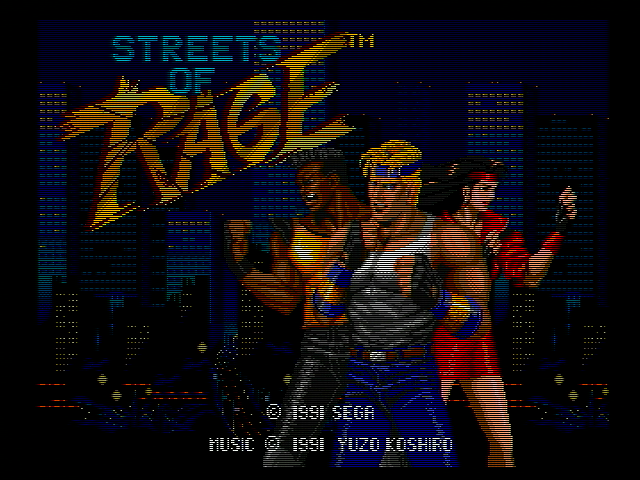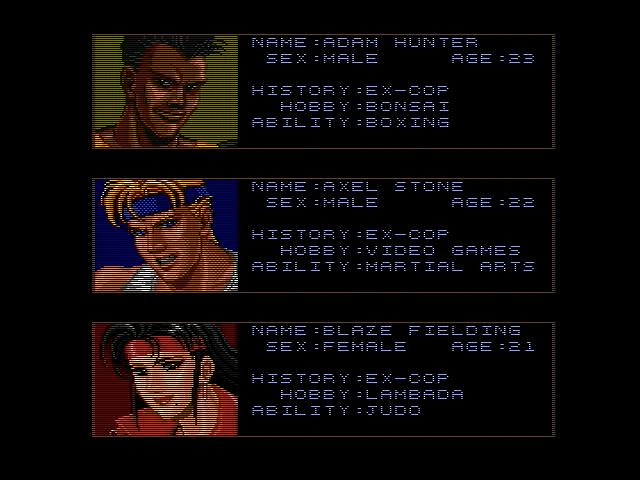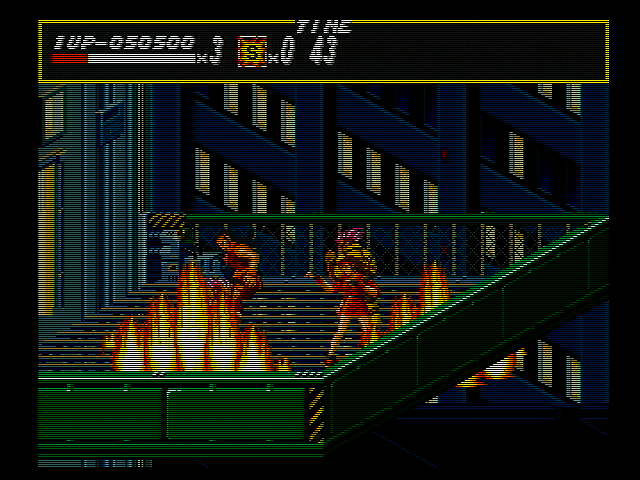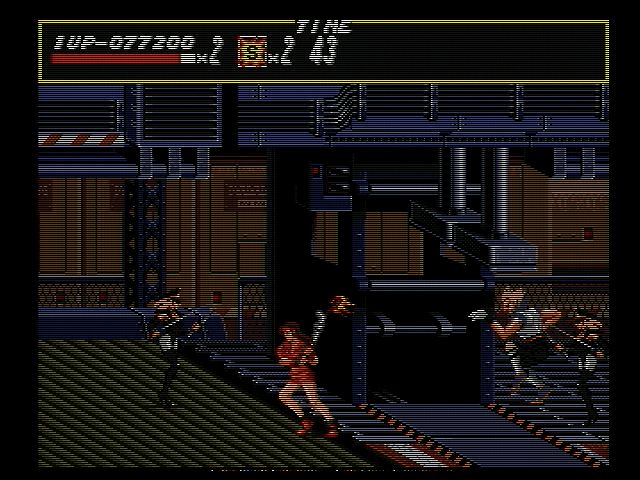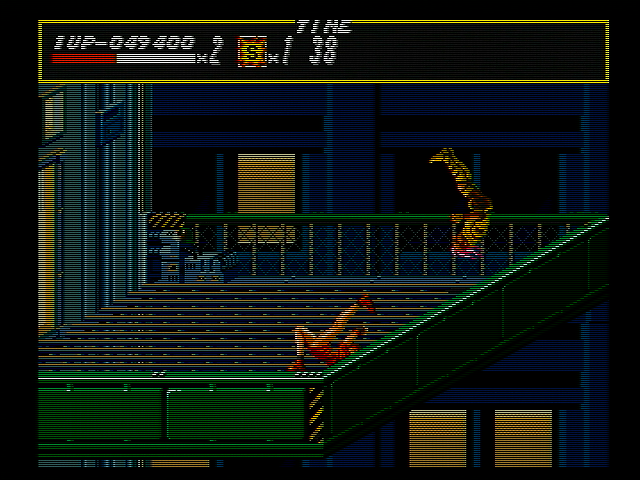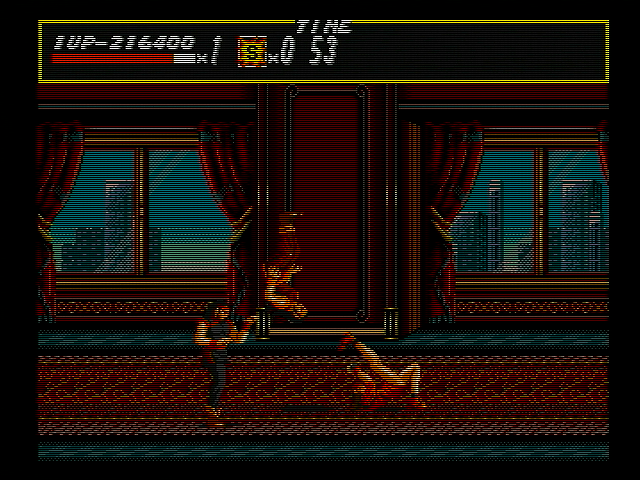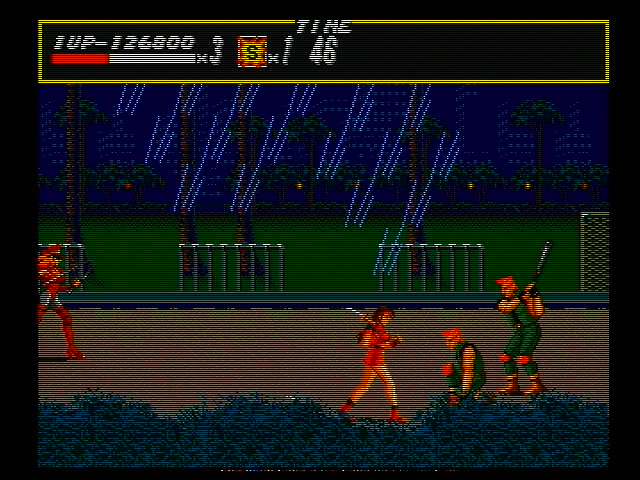Streets of Rage – Sega - 1991 - First time playing?: No, played as a teen
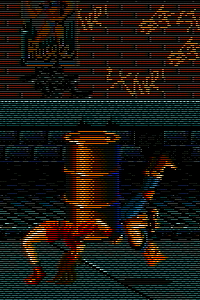 Streets of Rage is a game about some very angry streets. A bunch of punks, dominatrixes, martial artists and mobsters are violently infuriated by the fact that you dare to not be a mangled, bleeding mess on the floor, so they take it upon themselves to punch your nose in. There is a plot about a crime syndicate, a corrupt police force and disillusioned ex-cops taking the fight against crime into their own hands, but the title of the game says it all, frankly.
Streets of Rage is a game about some very angry streets. A bunch of punks, dominatrixes, martial artists and mobsters are violently infuriated by the fact that you dare to not be a mangled, bleeding mess on the floor, so they take it upon themselves to punch your nose in. There is a plot about a crime syndicate, a corrupt police force and disillusioned ex-cops taking the fight against crime into their own hands, but the title of the game says it all, frankly.
I'm hardly a beat-em-up expert. I generally don't really get the genre, struggling to understand how you're supposed to safely approach and attack enemies without having them just instantly kick you to the curb before you even have a chance. I have, however, played and beaten the first Streets of Rage as a teenager and remember enjoying it, although I only managed it by playing on easy mode. I felt inspired recently to revisit it and aim to beat it on normal mode this time, with the goal of coming to a better understanding and appreciation of the design and mechanics of this game.
You’ve got three characters to choose from here with subtle differences in how they play. Each character has a very similar move-set, although some small differences can change how viable certain strategies are, such as Adam’s backwards kick being much slower than Blaze’s. While all three characters are mostly balanced stat-wise, they all have one stat weaker than the other. For Adam it’s speed, for Axel it’s jumping and for Blaze it’s attack strength. I played through on normal difficulty with Blaze for this review, though I also played through half the game as Adam to get a feel for the differences in characters.
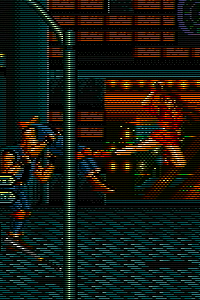 With our character selected it’s time to unleash rage upon these streets. The controls are pretty simple but there’s a few intricacies that aren’t immediately obvious without some experimentation. D-pad is to move, B button is attack and C button is jump. What attacks are performed when pressing the B button are determined by positioning. Generally you’ll do a standard punch which can be used in rapid succession for combos, however if you get close enough to an opponent then you will grab them, allowing you to hold them in place while you knee their face in and also use a variety of throws to send them flying, which can even be used to attack more enemies by clobbering them with your thrown victim. You can also jump kick by pressing the attack button in mid-air, or you can kick behind you by pressing the attack and jump buttons at the same time, allowing you to quickly hit an enemy trying to hit you with a back attack, situational for sure but excellent for defensive purposes and baiting enemies into thinking you’ve given them an opening.
With our character selected it’s time to unleash rage upon these streets. The controls are pretty simple but there’s a few intricacies that aren’t immediately obvious without some experimentation. D-pad is to move, B button is attack and C button is jump. What attacks are performed when pressing the B button are determined by positioning. Generally you’ll do a standard punch which can be used in rapid succession for combos, however if you get close enough to an opponent then you will grab them, allowing you to hold them in place while you knee their face in and also use a variety of throws to send them flying, which can even be used to attack more enemies by clobbering them with your thrown victim. You can also jump kick by pressing the attack button in mid-air, or you can kick behind you by pressing the attack and jump buttons at the same time, allowing you to quickly hit an enemy trying to hit you with a back attack, situational for sure but excellent for defensive purposes and baiting enemies into thinking you’ve given them an opening.
Perhaps the most infamous attack in Streets of Rage however is the firebomb, something so absurdly over-the-top that it’s practically memetic. Once per life you can press a button to summon a cop car to drive up and pull out a rocket launcher which fires a screen-covering explosive that does heavy damage to everyone except for you. The fact that your player character completely no-sells a massive explosive is already peak video game logic, but this also raises questions about the story that I said wasn’t important in the first paragraph. The intro states that the crime syndicate has taken control over the police force of this city, thus all of the player characters are ex-cops, so what’s the allegiance of the cop car driver? If he is a cop then why is he exclusively attacking his own allies? Here’s my two theories. Theory number one is that this guy is also an ex-cop but he took the weapons, car and uniform with him as he left to enforce his own justice, essentially becoming a terrorist. Alternatively, the guy was never a cop and is just a mad arsonist who also hates the syndicate and he stole a cop car and uniform as it’s an effective cover for his pyromaniacal frenzy. Then again, even if he is a cop, I suspect his wanton gratuitous violence would be completely and utterly mundane in this violent Neo Detroit urban hellscape.
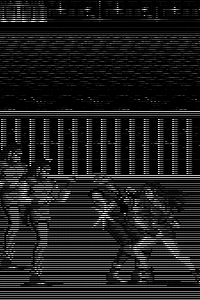 For as simple as the controls are, there’s a pretty solid diversity in the few moves you have, ensuring that you’re well stocked on options for any combat situation the game can throw at you, thus offering potential for strategy as well as situational advantages on the fly. This is important because movement in general is very sluggish, not helped by the game bizarrely running at 30FPS as opposed to the more standard 60FPS you usually see in Mega Drive games. Enemies are frequently much faster than you are and you don’t have many options in terms of dodging out of the way of attacks. You also move even slower vertically than you do horizontally, so if an enemy is charging at you horizontally you’re going to have a hard time trying to step out of the way of that attack. A jump kick could potentially save you in that situation as it reliably knocks enemies down, thus interrupting the charge, though there’s other factors and drawbacks that need to be considered when using that attack. The jump kick is still knocking enemies back, creating more distance between you and your opponent and thus giving them the time and space they need to ready another charge. All attacks have advantages and drawbacks like that which need to be considered.
For as simple as the controls are, there’s a pretty solid diversity in the few moves you have, ensuring that you’re well stocked on options for any combat situation the game can throw at you, thus offering potential for strategy as well as situational advantages on the fly. This is important because movement in general is very sluggish, not helped by the game bizarrely running at 30FPS as opposed to the more standard 60FPS you usually see in Mega Drive games. Enemies are frequently much faster than you are and you don’t have many options in terms of dodging out of the way of attacks. You also move even slower vertically than you do horizontally, so if an enemy is charging at you horizontally you’re going to have a hard time trying to step out of the way of that attack. A jump kick could potentially save you in that situation as it reliably knocks enemies down, thus interrupting the charge, though there’s other factors and drawbacks that need to be considered when using that attack. The jump kick is still knocking enemies back, creating more distance between you and your opponent and thus giving them the time and space they need to ready another charge. All attacks have advantages and drawbacks like that which need to be considered.
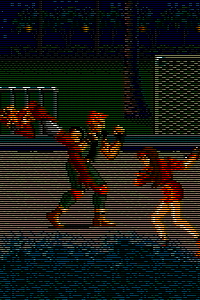 Regardless, you are still outnumbered and often outclassed. In addition to enemies being faster than you they’re also often armed, such as the dominatrixes wielding whips which hit fast and with good range, or the jugglers who throw all kinds of ranged projectiles at you such as hatchets or lit torches. You can get a few weapons yourself to even the odds such as baseball bats, pipes and knives, either found in the levels or stolen from downed enemies, but the weapons of the dominatrixes and jugglers are never available for the player’s use. Bosses get even more unfair advantages, the final boss even has a machine gun to shoot you to shreds with. So, if you can’t overpower your opponents, that leaves you with outwitting your opponents instead. AI manipulation is an integral part of Streets of Rage. Enemies react in different ways depending on your positioning and whether or not you are facing them or not. It’s common for enemies to approach you if your back is facing them, while they’re more likely to hesitate or even back up if you approach them instead. This is especially important with bosses. I was having a lot of trouble with the second boss burning through my extra lives until I learnt that approaching him from above or below while repeatedly zigzagging left and right tended to confuse him enough to safely be able to grab him. By contrast, I had an easier time with the stage 5 bosses by facing away from them in a corner and back kicking them any time they got close
Regardless, you are still outnumbered and often outclassed. In addition to enemies being faster than you they’re also often armed, such as the dominatrixes wielding whips which hit fast and with good range, or the jugglers who throw all kinds of ranged projectiles at you such as hatchets or lit torches. You can get a few weapons yourself to even the odds such as baseball bats, pipes and knives, either found in the levels or stolen from downed enemies, but the weapons of the dominatrixes and jugglers are never available for the player’s use. Bosses get even more unfair advantages, the final boss even has a machine gun to shoot you to shreds with. So, if you can’t overpower your opponents, that leaves you with outwitting your opponents instead. AI manipulation is an integral part of Streets of Rage. Enemies react in different ways depending on your positioning and whether or not you are facing them or not. It’s common for enemies to approach you if your back is facing them, while they’re more likely to hesitate or even back up if you approach them instead. This is especially important with bosses. I was having a lot of trouble with the second boss burning through my extra lives until I learnt that approaching him from above or below while repeatedly zigzagging left and right tended to confuse him enough to safely be able to grab him. By contrast, I had an easier time with the stage 5 bosses by facing away from them in a corner and back kicking them any time they got close
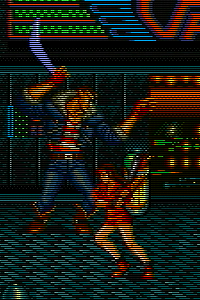 Bosses were definitely the biggest hurdle for me due to the lack of feedback they give in terms of when they will attack you. There’s little to no windup or telegraphing to most of their attacks, so if they’ve started their attack animation it’s already too late. They can easily hit you before you’re even in range to attack and they do huge amounts of damage too, often taking off a third of your health with a single hit. There are, however, rules to how they behave which can be exploited with practice. I would have appreciated some kind of boss rush mode where I could practise fighting them repeatedly without having to play through their whole stage since experimentation really is key, which is hard when you’re playing a game with no saving and limited continues. You also can’t rely on the firebomb, as the final level contains a boss rush that you’re required to fight through entirely on your own, no cop car to back you up here.
Bosses were definitely the biggest hurdle for me due to the lack of feedback they give in terms of when they will attack you. There’s little to no windup or telegraphing to most of their attacks, so if they’ve started their attack animation it’s already too late. They can easily hit you before you’re even in range to attack and they do huge amounts of damage too, often taking off a third of your health with a single hit. There are, however, rules to how they behave which can be exploited with practice. I would have appreciated some kind of boss rush mode where I could practise fighting them repeatedly without having to play through their whole stage since experimentation really is key, which is hard when you’re playing a game with no saving and limited continues. You also can’t rely on the firebomb, as the final level contains a boss rush that you’re required to fight through entirely on your own, no cop car to back you up here.
As expected of a beat-em-up, this game starts with you punching dudes and ends with you punching dudes. There’s not much variety, but there’s enough to keep the game engaging for its fairly short length. Aside from just having different enemy types introduced as you progress and having you visit new locations, there’s a few notable stage gimmicks that are fun to exploit. Stage 6 has conveyor belts for you to fight on, but more sadistically there’s also crushers that are activated if you get too close to them. Throw an enemy under the crusher and then get close enough to activate it and watch them get pounded. Stage 7 meanwhile takes place entirely on an elevator attached to the side of the syndicate’s skyscraper. It’s a cramped environment which makes fighting even the most common enemies difficult, but it never stops being fun throwing them over the edge of the elevator and seeing them plummet to the ground.
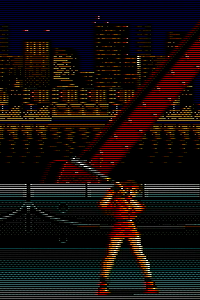 Overall I have fun with Streets of Rage’s gameplay, but what really elevates it for me is the overall presentation. Low framerate aside, the game looks great and has a wonderful sense of style. It’s harsh and gritty, but manages to pull off that vibe even while being bright and colourful, not falling into the usual pitfall of making everything washed out and beige. The bright neon lights and punk fashion contrasted against grey concrete streets and the dark night sky works perfectly to create the same kind of lively atmosphere you get from something like Duke Nukem 3D, great for brutal yet energetic arcade style action. The sound effects likewise give a lot of satisfying crunchy impact to your attacks. There’s plenty of joy to come just from hearing the bodies hit the floor with that weighty thud, while the bit-crushed cries of pain are far less grating and more cathartic than what we previously heard in the earlier Mega Drive beat-em-up Golden Axe. The sound effects don’t really sound like punching dudes, they’re maybe a little too metallic sounding for fists hitting bodies, but that in itself is satisfying in its own way, still conveying the impact of the blow well.
Overall I have fun with Streets of Rage’s gameplay, but what really elevates it for me is the overall presentation. Low framerate aside, the game looks great and has a wonderful sense of style. It’s harsh and gritty, but manages to pull off that vibe even while being bright and colourful, not falling into the usual pitfall of making everything washed out and beige. The bright neon lights and punk fashion contrasted against grey concrete streets and the dark night sky works perfectly to create the same kind of lively atmosphere you get from something like Duke Nukem 3D, great for brutal yet energetic arcade style action. The sound effects likewise give a lot of satisfying crunchy impact to your attacks. There’s plenty of joy to come just from hearing the bodies hit the floor with that weighty thud, while the bit-crushed cries of pain are far less grating and more cathartic than what we previously heard in the earlier Mega Drive beat-em-up Golden Axe. The sound effects don’t really sound like punching dudes, they’re maybe a little too metallic sounding for fists hitting bodies, but that in itself is satisfying in its own way, still conveying the impact of the blow well.
But you know the real star of the presentation already, don’t you? Yep, it is of course the soundtrack. I don’t know what else to add, the music in the Streets of Rage series is absolutely legendary. Yuzo Koshiro’s mastery of the Mega Drive sound chip was so many leagues ahead of nearly every other soundtrack on the console up to that point, creating absolutely wonderful energetic EDM tracks which uses all of the hardware’s strengths to its advantage. This is the kind of soundtrack you use as a counter argument to anyone who doubts the value of chiptune music.
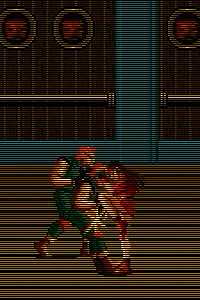 Now, I haven’t played through Streets of Rage 2 yet, but its reputation as one of the greatest games of all time precedes it, to the point that many fans find it hard to go back to Streets of Rage 1 after having played its more refined successor, so I decided to play the first stage of Streets of Rage 2 before reviewing Streets of Rage 1 just to do a quick comparison. And yep, that reputation is well earned, Streets of Rage 2 improves on its predecessor in every single way. The controls, the sound effects, the framerate, the graphics, they’re improved across the whole board. Heck, Yuzo Koshiro even managed to improve on perfection and make a soundtrack even better than Streets of Rage 1. I’ll save more details for when I play through Streets of Rage 2 in full and review it as well, but the reason I bring this up is that if you’re going to play one game in this series, you’re probably better off playing that one instead. Streets of Rage 1 is no slouch however, it’s undoubtedly clunkier and more sluggish but it’s not irresponsive and remains a solidly designed game that’s satisfying to master. If you’re into retro games you are probably used to the kind of jank you’ll experience in Streets of Rage 1, but until you figure out the boss strategies it can be quite the unforgiving game. Even when I game overed however the game remained fun enough for me to want to start again on the spot, apply all I learnt in my last attempt and try new strategies along the way. I enjoyed Streets of Rage 1, and while I see myself loving Streets of Rage 2 more in the future, I respect this solid start with its infectious sense of style and energy that elevates this title from good to great and leaves the game immediately loveable.
Now, I haven’t played through Streets of Rage 2 yet, but its reputation as one of the greatest games of all time precedes it, to the point that many fans find it hard to go back to Streets of Rage 1 after having played its more refined successor, so I decided to play the first stage of Streets of Rage 2 before reviewing Streets of Rage 1 just to do a quick comparison. And yep, that reputation is well earned, Streets of Rage 2 improves on its predecessor in every single way. The controls, the sound effects, the framerate, the graphics, they’re improved across the whole board. Heck, Yuzo Koshiro even managed to improve on perfection and make a soundtrack even better than Streets of Rage 1. I’ll save more details for when I play through Streets of Rage 2 in full and review it as well, but the reason I bring this up is that if you’re going to play one game in this series, you’re probably better off playing that one instead. Streets of Rage 1 is no slouch however, it’s undoubtedly clunkier and more sluggish but it’s not irresponsive and remains a solidly designed game that’s satisfying to master. If you’re into retro games you are probably used to the kind of jank you’ll experience in Streets of Rage 1, but until you figure out the boss strategies it can be quite the unforgiving game. Even when I game overed however the game remained fun enough for me to want to start again on the spot, apply all I learnt in my last attempt and try new strategies along the way. I enjoyed Streets of Rage 1, and while I see myself loving Streets of Rage 2 more in the future, I respect this solid start with its infectious sense of style and energy that elevates this title from good to great and leaves the game immediately loveable.
- Page written by MSX_POCKY, 31st May 2024
